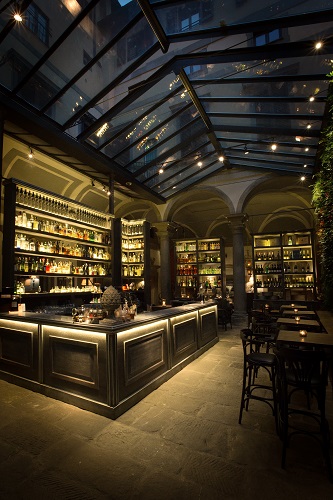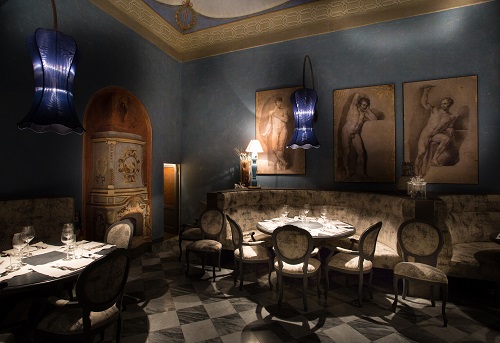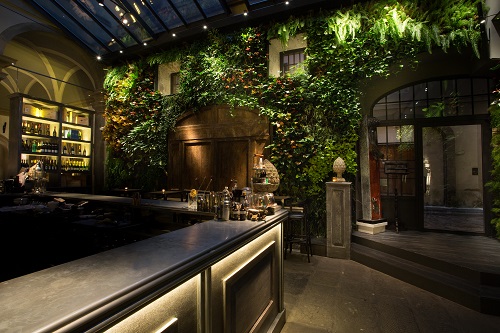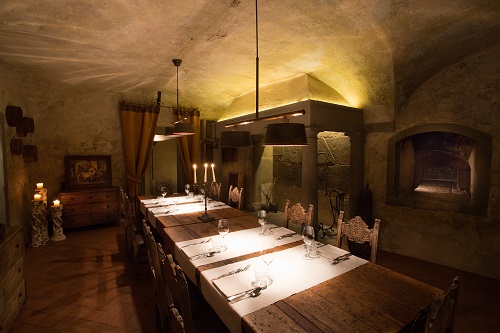Visit Florence
- Art & culture
- Tastings & Cooking Classes
- Florence Outdoor
- Day tours
- Events
- Shopping
- Hotels in Florence
Be.Curious
Destination Florence

What you will find
The city and its taste, its elegance, its memory to be savored on two floors, contiguous but separated by a staircase that has the scent of a time machine, for a unforgettable experience between cuisine, visual sensations, atmospheric and new emotions, reaffirmed the pleasure of conviviality and sociability. In the era of virtual squares, here is a sort of "covered square", sheltered from indiscreet intrusions, which plunges into the pleasure of a cocktail or a glass of champagne as a haute cuisine dish consumed in joy and friendship in close contact with History, and in the midst of a thousand quotations and references that refer to the Paris of Prévert, the disco-clubs of New York or London and even a vertical garden.
It's called LOCALE?, but in the logo it also has the symbol of infinity, a sense of an all-round look in time and space on Florence and Florentinity, the new elegant yet accessible restaurant conceived by Giacomo Corti, former owner of the Cestello RistoClub and the Convivium. It is located in via delle Seggiole, in the historic center of Florence, between the Duomo, Palazzo Vecchio and Santa Croce, a stone's throw from the Bargello Museum and the House of Dante Alighieri. It is the ancient heart of the city, summarized in the prestigious palace chosen for this new, compelling adventure: Palazzo delle Seggiole, that is Palazzo Medici Tornaquinci, which brings back to the court of Grand Duke Cosimo I and his skilled plenipotentiary Bartolomeo Concini, whose daughter would be united in marriage with Cosimo di Francesco de 'Medici of the Castellina branch, then become Medici Tornaquinci. Years in which around the Medici court gravitated characters and artists such as Giorgio Vasari, Benvenuto Cellini and many others. The building has a clear fifteenth-century mark, but its origins are much older: Via delle Seggiole was in fact called Canto dei Bastari, as stated on the plaque affixed to the same building in the corner with Via de 'Pandolfini. And it was the Bastari (or Bastai) - Rittafè who were its ancient owners, in the XIII century, when the building still had the forms of poorer but well-kept houses, even equipped with basements and escape routes.
And the passage through these two different environments is just the dip in the two floors that this extraordinary "time machine" gives to those who enter: the current ground floor with the Renaissance and Medicean splendor, and the ancient plan of the municipal Florence. With an emotional impact of great effect: the large entrance opens to the view of a jardin d'hiver that is a modern vertical garden, thanks to the fascinating wings made of plants that rise on the walls until reaching the special thermal glass cover that can be opened thanks to a mechanism made with advanced technology.
THE ENVIRONMENTS
It is the restaurant's lounge, which in turn functions as a wine and cocktail bar. Minimal furniture in satin oak wood between gray and black with a wise patina of "dirty" to recall the essentiality of the environment witnessed by the original floor, simply cleaned up like everything else that existed in the rooms since the Medici era . The large central counter recalls the disco club work stations with cocktails in "absolute black". But the plan of zinc brings back to the Paris of Jacques Prévert and his Grasse Matinée, "the est terrible le petit bruit de l'oeuf dur cassé sur a comptoir d'étain" (the slight noise of a hard-boiled egg is terrible. on a zinc bench), also underlined by the bistro model chairs and tables. All around, an effect of great suggestion is created by the shelves of the led-lit bottles and interspersed by large refrigeration columns for champagne and white wines, true spiers of the wine list in the bar. Here you can also enjoy snacks, quick meals or the same dishes prepared by the kitchen and served at the restaurant tables, but in an easier way in the covered square.
The rooms of the restaurant, on the ground floor, keep intact the charm of the 1500, between an authentic tiled stove with the Medici and Concini emblems, the stuccos and the frescoes on the ceilings (the frieze with the Cherub of the wine was a good omen. and the artichoke symbols of good harvest) or the windows to the big doors. All new, but with a powerful reminder of the ancient though non-invasively, the design of the tables and armchairs with tapestries that recall the ancient damask and foiled velvets. A refined style but not in plaster in the transition from the lounge to the lounges. The atmosphere that leads back to the rooms of an ancient palace is completed by the painted decoupage walls, half-columns in pietra serena, large bell-shaped lamps on the tables accompanied by discreet wall sconces, statues by Onofrio Pepe in the niches on the walls, with soft curtains. But an antique chandelier, original, in Murano glass hangs from the ceiling of the "bookcase" room, graceful privé separated from the rest by a precious drapery.
A stone staircase in the lounge is the extraordinary "time machine" that allows diving in a completely different era. A few steps, and we are in the Middle Ages, at the time of the Bastari family. A round-vaulted corridor-tunnel that you imagine a time illuminated by torches, the rooms that open at the sides. Everything changes, starting from the materials, here more Spartan and essential lines. Large sturdy tables and chairs, a geometric counter: here we are in the former laundry of Milleduecento, where the plaster is still the original one simply cleaned to be the setting for dinners-tasting of groups and companies or events, in the medieval style, with wine served exclusively in magnum-sized bottles.
The old kitchen with the large fireplace, the stone sink and the oven that brings the octagonal cross of the Knights of Santo Stefano, with a round table, beautiful leather chairs and tapestries, make a strong impact. . At the end of the corridor, also conceived as a 360-degree "projection room" for wineries whose products are displayed in the display cabinets along the walls, a gate closes the "Schatzkammer", the "treasure room" borrowed from large noble cellars, where the finest bottles are enclosed.
Where / Meeting point
Via delle Seggiole 12r - 50122 Firenze (FI)
 LOCALE
LOCALE









 All the services are provided by local merchants
All the services are provided by local merchants By using this site you support Florence
By using this site you support Florence We offer products with high-quality standards
We offer products with high-quality standards You stay sustainable
You stay sustainable It's a 100% trustworthy website
It's a 100% trustworthy website